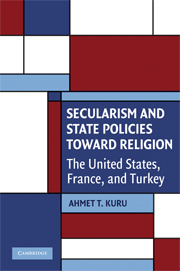Book contents
- Frontmatter
- Contents
- List of Figures and Tables
- Glossary of Abbreviations
- Acknowledgments
- Secularism and State Policies toward Religion
- Introduction
- 1 Analyzing Secularism
- PART I THE UNITED STATES
- PART II FRANCE
- PART III TURKEY
- Conclusion
- Appendix A State-Religion Regimes Index of 197 Countries
- Appendix B Human Development and Official Religion in 176 Countries
- Appendix C State-Religion Regimes in Forty-Six Muslim Countries
- Appendix D Turkey's National Security Council Decisions, February 28, 1997
- Bibliography
- Index
Conclusion
Published online by Cambridge University Press: 05 June 2012
- Frontmatter
- Contents
- List of Figures and Tables
- Glossary of Abbreviations
- Acknowledgments
- Secularism and State Policies toward Religion
- Introduction
- 1 Analyzing Secularism
- PART I THE UNITED STATES
- PART II FRANCE
- PART III TURKEY
- Conclusion
- Appendix A State-Religion Regimes Index of 197 Countries
- Appendix B Human Development and Official Religion in 176 Countries
- Appendix C State-Religion Regimes in Forty-Six Muslim Countries
- Appendix D Turkey's National Security Council Decisions, February 28, 1997
- Bibliography
- Index
Summary
This book examines two opposite policy tendencies toward religion. U.S. policies are generally tolerant toward religion in the public sphere, while the French and Turkish states largely try to confine it to the private domain. According to the American legal system, neither the federal government nor states can prohibit religious symbols in general, or symbols of a particular religion, by singling them out. In France and Turkey, however, the state has singled out students' religious attire to exclude them from public schools without having a general regulation due to a practical (e.g., health or security) purpose. If the headscarf had been a secular fashion, then it would not have been banned in France and Turkey.
I analyze this policy difference through ideological dominances and struggles in these three cases. In the United States, two major groups, the accommodationists and separationists, have had several disagreements on state-religion relations. Yet they both oppose state policies that would prohibit individuals' display of religious symbols in the public sphere. In this regard, these groups defend two different interpretations of passive secularism. In France, however, the combative secularists have succeeded in establishing the dominance of assertive secularism, which aims to exclude religion from the public sphere.
- Type
- Chapter
- Information
- Secularism and State Policies toward ReligionThe United States, France, and Turkey, pp. 236 - 246Publisher: Cambridge University PressPrint publication year: 2009

